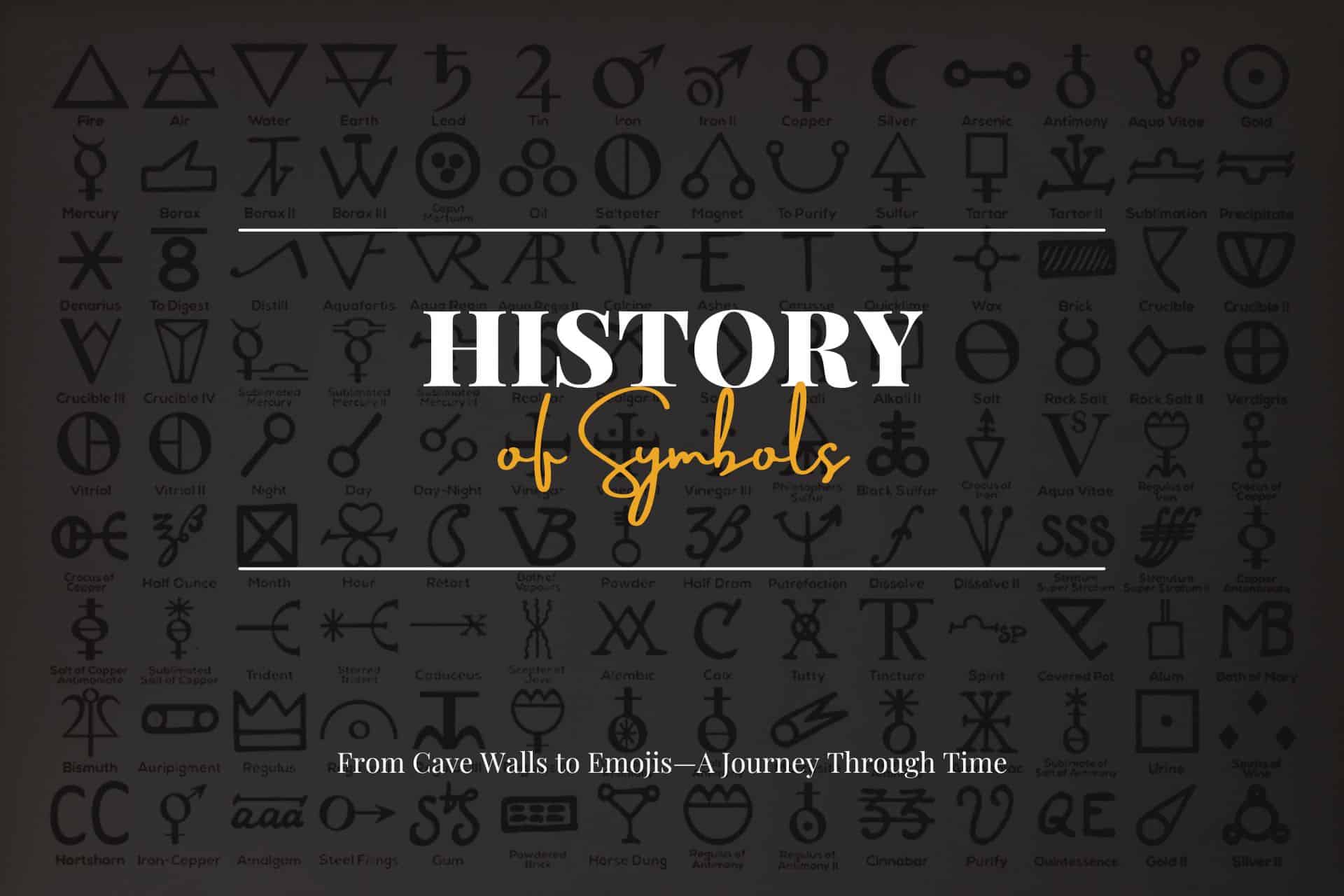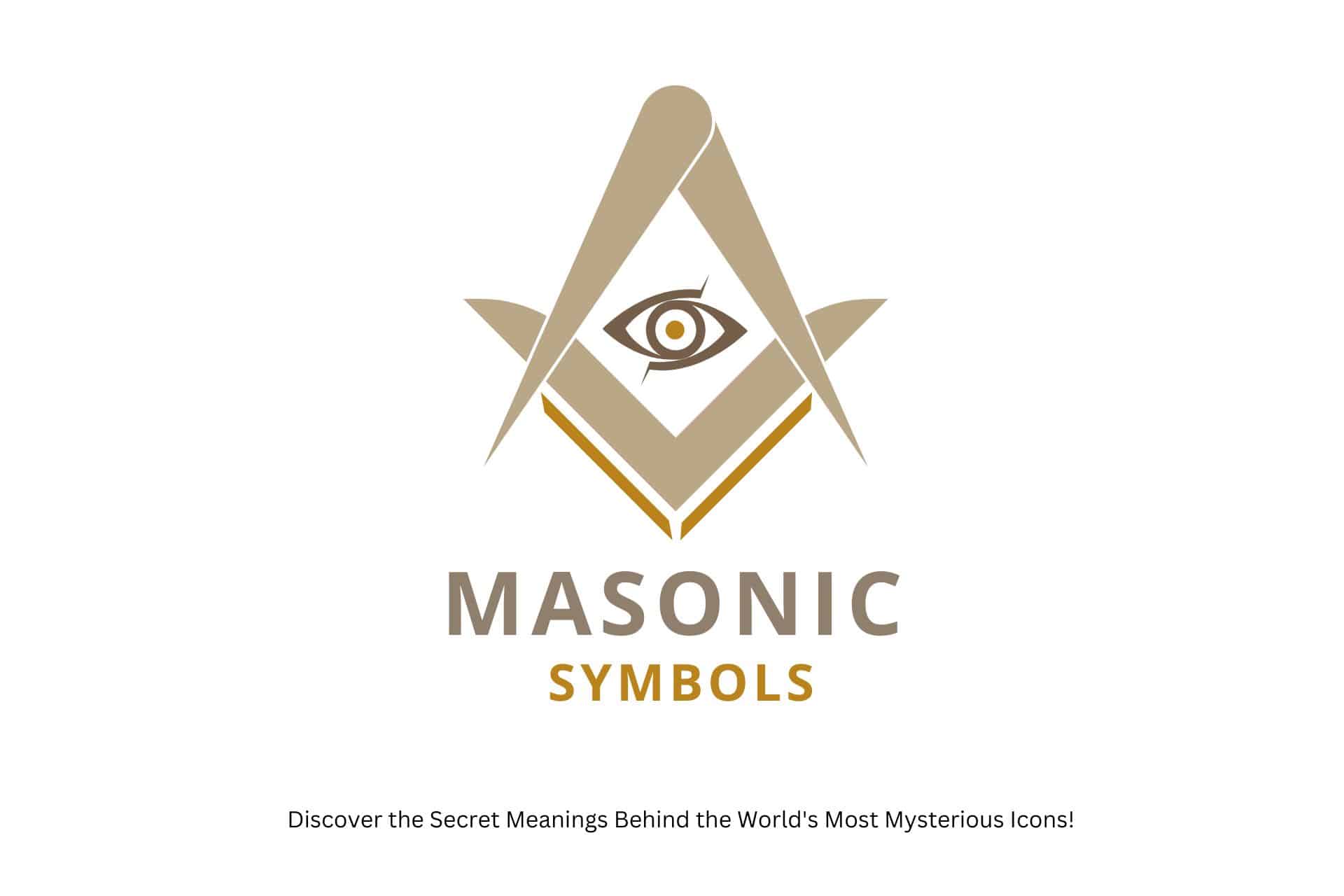Unlock the Hidden Stories Behind Everyday Characters!
Have you ever wondered about the stories and meanings behind the symbols you encounter daily in texts, equations, or currencies? Have you ever paused to consider a symbol’s origins or significance?
This article is your gateway to understanding the rich tapestry of typographic symbols that punctuate our written world. We unravel the mysteries of these symbols, providing insights into their history, significance, and cultural differences.
Discover the value of knowing more than just the basics—unlock a new dimension of literacy that enhances your reading, writing, and comprehension skills.
Ready to elevate your understanding of typographic symbols?
Continue reading to uncover the layers of meaning behind the characters that shape our communication.
Let’s get started!
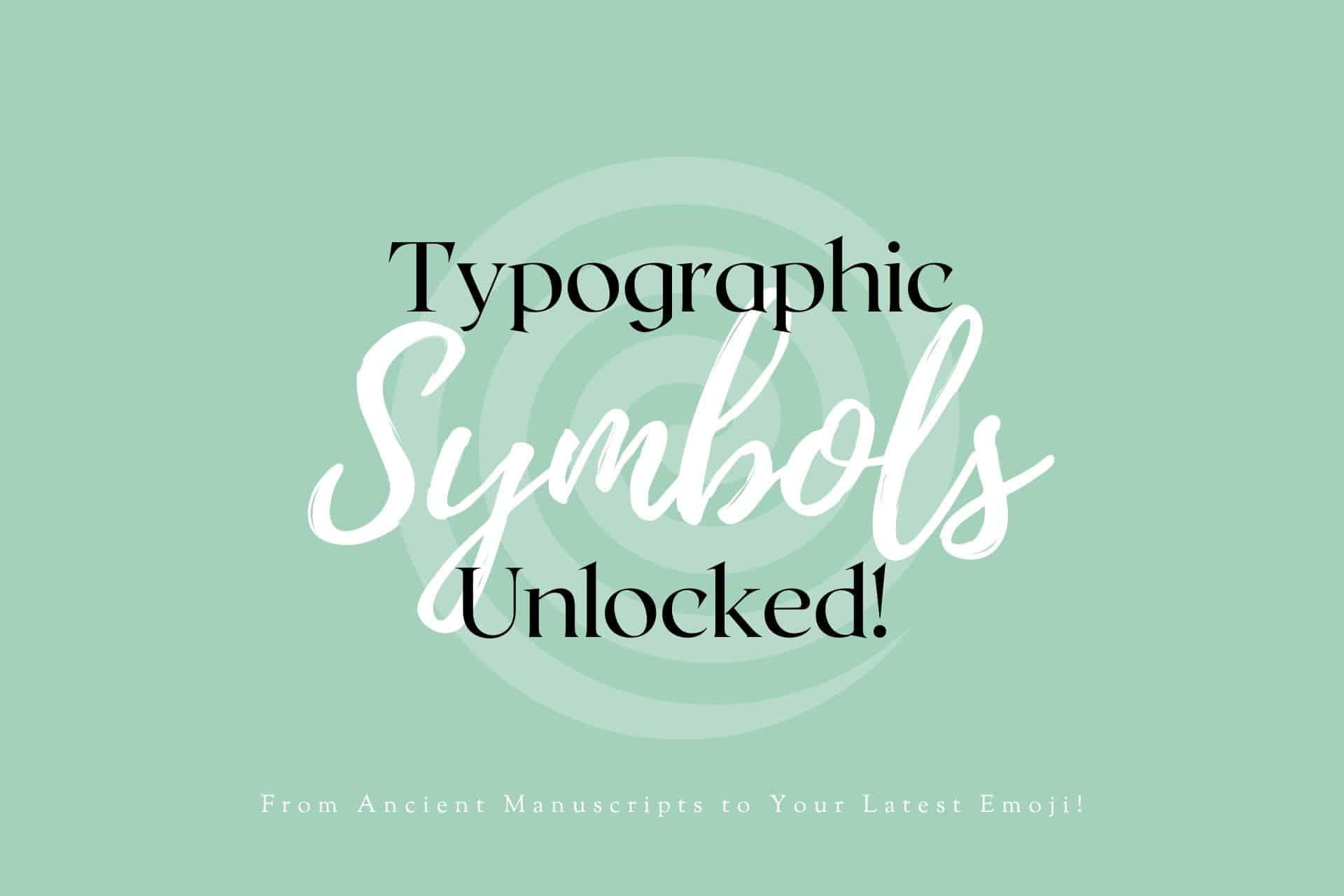
Here’s What You Will Find

Key Takeaways
Typographic Symbols
Typographic Symbols Are Everywhere: From the punctuation marks that guide our reading to the currency symbols that dominate financial transactions, typographic symbols play a crucial role in our daily communication, enriching texts and conveying complex ideas across languages and cultures.
A Rich Historical Tapestry: The origins of typographic symbols stretch back to ancient civilizations, evolving from pictographs and hieroglyphs to the sophisticated characters used in today’s digital fonts. This evolution mirrors the advancement of human communication and technology.
Understanding Equals Empowerment: Familiarity with typographic symbols enhances readability and design and empowers individuals to communicate more effectively. Recognizing and utilizing these symbols correctly can significantly impact the clarity and precision of our written expression.
Digital Age Revolution: The advent of digital communication has not only preserved the traditional use of typographic symbols but has also introduced new ones, such as emojis, further expanding our ability to express emotions and ideas in a visually engaging and universally understandable manner.
What Are Typographic Symbols?
Definition and Overview
Typographic symbols, in their essence, are the glyphs and characters that provide structure, emphasis, and clarity to written text, transcending the alphabet to include a wide range of non-alphabetic characters.
These symbols encompass everything from the common comma to the less frequently encountered interrobang. Each symbol carries a specific function, helping to bridge the gap between the fluidity of spoken words and the static nature of written text.
They serve as mere decorations and crucial tools for effective communication.
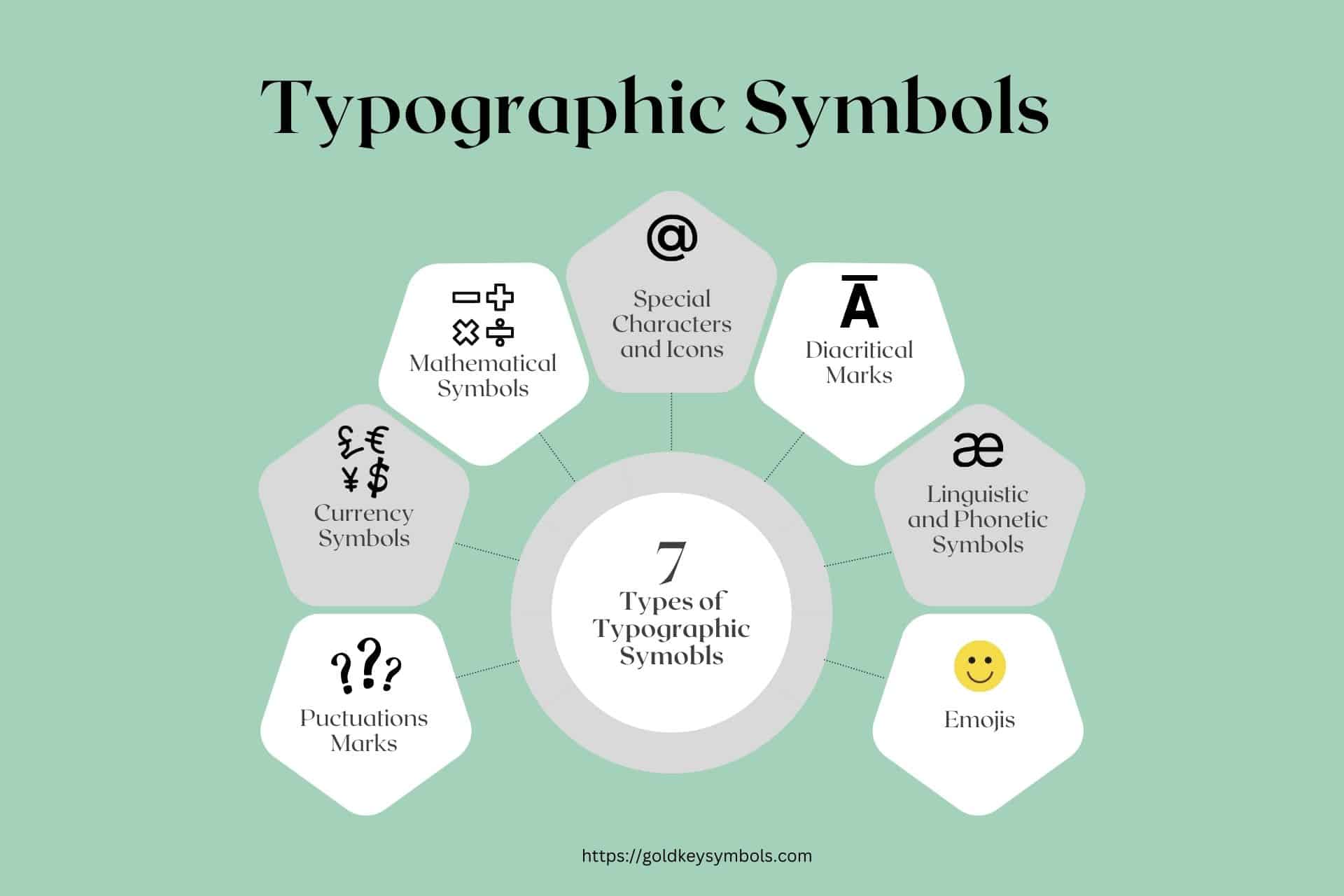
Types of Typographic Symbols
Understanding the Diversity of Typographic Symbols
Typographic symbols encompass many characters, each serving a unique purpose in enhancing written communication’s clarity, expression, and functionality. These symbols can be broadly categorized into several types, reflecting their diverse roles across different contexts:
Punctuation Marks
Punctuation marks are the sentinels of syntax, guiding readers through the structure of written language. They include familiar characters like commas, periods, question marks, and exclamation points as well as more specialized symbols like quotation marks, parentheses, brackets, and dashes.
Each mark influences the pace, tone, and meaning of sentences, helping to mimic the nuances of spoken language in written form.
Currency Symbols
Currency symbols, such as the dollar sign ($), euro (€), pound sterling (£), yen (¥), and many others, denote monetary values and facilitate international financial transactions. These symbols represent economic exchange and carry cultural and historical significance, reflecting the global nature of trade and commerce.
Mathematical Symbols
Mathematical symbols form the backbone of scientific and mathematical communication. Beyond basic operations like addition (+), subtraction (−), multiplication (×), and division (÷), this category includes symbols for inequalities, integrals, sums, and various constants. These symbols allow for the concise expression of mathematical concepts and relationships.
Special Characters and Icons
This broad category includes a wide range of symbols used for specific purposes, such as copyright (©), trademark (™), registered trademark (®), degree (°), and section (§) symbols. It also encompasses various technical symbols used in computing, like the at sign (@) for email addresses and angle brackets (<>) in programming languages.
Diacritical Marks
Diacritical marks are symbols added to letters to indicate a change in pronunciation, such as the acute (´), grave (`), and circumflex (^) accents found in many languages. These marks are essential for conveying the correct pronunciation and meaning of words in different languages.
Linguistic and Phonetic Symbols
This category includes symbols used in phonetic alphabets, such as the International Phonetic Alphabet (IPA), to represent specific sounds in spoken languages. These symbols are crucial for linguists, language learners, and researchers in accurately transcribing and studying spoken language.
Emojis
Emojis are pictographic symbols used in digital communication to express emotions, activities, and concepts. These colorful and expressive icons have become a universal language in their own right, enabling people to convey feelings and reactions in a visually engaging way.
Each category of typographic symbols significantly enriches written communication, making it more expressive, precise, and accessible across different languages and media. Understanding the diverse types of typographic symbols is essential for effective communication in our increasingly interconnected world.
The multifaceted nature of typographic symbols is a testament to their utility across different contexts and disciplines. They enable precision and richness in written communication that words alone cannot achieve.
The Origins of Typographic Symbols
A Brief History: From Ancient Manuscripts to Digital Fonts
The history of typographic symbols is as old as writing, evolving from pictographs and hieroglyphs used in ancient civilizations to the sophisticated characters of today’s digital fonts. The invention of the printing press in the 15th century marked a significant turning point, standardizing the use of typographic symbols and making written material more accessible.
The journey of typographic symbols from ancient manuscripts to digital fonts is a fascinating narrative that mirrors the evolution of human communication.
Initially, writing systems such as pictographs and hieroglyphs in ancient civilizations like Egypt and Sumer were more than mere representations of spoken language; they were artistic expressions that blended the visual with the verbal. These early symbols, deeply rooted in the cultures that created them, conveyed complex ideas, rituals, and stories.
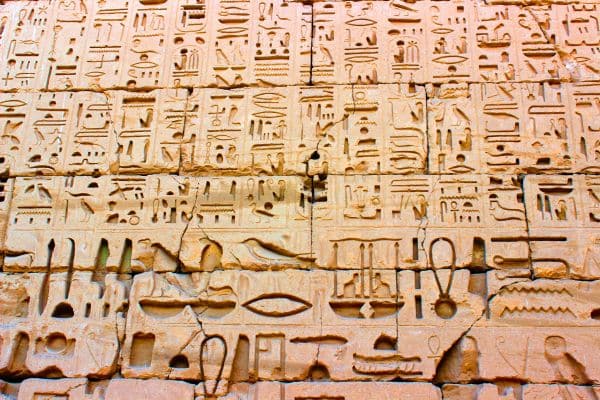
As civilizations advanced, the need for more streamlined and versatile writing systems emerged, leading to the development of alphabets and the subsequent creation of early typographic symbols. These symbols, including punctuation marks and diacritics, were essential for clarifying meaning and making texts more accessible to read and understand.
Johannes Gutenberg’s 15th-century invention of the printing press was a pivotal moment in the history of typographic symbols. This innovation democratized access to information and necessitated the standardization of typographic symbols, ensuring consistency across printed materials.
The printing press paved the way for the rapid spread of knowledge, contributing to significant cultural and scientific advancements during the Renaissance and beyond.
In the centuries that followed, the evolution of typographic symbols continued in tandem with technological advancements. The industrial revolution brought about mechanized printing techniques, further refining the production and design of typographic symbols. The 20th century saw the transition from metal typesetting to digital fonts, a leap that expanded the possibilities for typographic design and introduced a new era of digital communication.
Today, digital fonts allow for an unprecedented level of creativity and flexibility in the use of typographic symbols. The development of Unicode has standardized these symbols across different platforms and languages, ensuring that they retain their meaning and appearance in digital spaces.
This digital evolution has not only preserved typographic symbols’ rich history but also set the stage for their continued innovation and adaptation in the future.
How Were Typographic Symbols Created and Adopted?
Many typographic symbols were born out of necessity, their forms shaped by the limitations of early printing technology and the demands of expanding literacy.
The ampersand (&), for example, evolved from the Latin word “et,” meaning “and,” its design a result of scribes’ efforts to save space and speed up the writing process. Over time, as written communication expanded from manuscripts to mass-produced texts, these symbols were refined and adopted into the typographic canon.
The standardization of typographic symbols, however, was not a swift process. Variations existed across languages and regions, reflecting the diverse ways in which people communicated. The advent of digital typography and the development of the Unicode Standard have played crucial roles in harmonizing these symbols, ensuring consistency across different platforms and media.
Understanding the Unicode Standard
What is Unicode?
Unicode is a universal character encoding standard that provides a unique number for every character, no matter the platform, program, or language. It encompasses more than typographic symbols, including letters from living and historic scripts, making digital communication global.
Why is Unicode Important for Typographic Symbols?
By assigning a unique identifier to each typographic symbol, Unicode ensures that these characters remain consistent and accessible across different digital environments.
This standardization is crucial for preserving the integrity of written communication in a digital age, enabling symbols to be used and understood universally without the risk of misinterpretation or loss of meaning when transferred between different systems or languages.
The Unicode Standard represents a significant achievement in the history of typographic symbols, ensuring that these vital components of written communication remain practical and relevant in an increasingly connected world.
The Art and Science of Typography
How Typographic Symbols Influence Readability and Design
The arrangement and choice of typographic symbols profoundly impact readability and the aesthetic appeal of text. Proper punctuation can make text easier to navigate and understand, while a thoughtful selection of symbols can enhance the visual layout, guiding the reader’s eye through the content.
At its core, typography is an art form that marries functionality with beauty, where symbols play a pivotal role.
The Psychological Impact of Typographic Choices
The psychology of symbols is an integral aspect of typography. The selection and arrangement of typographic symbols impact readability and aesthetic appeal and can evoke emotions and set the tone of written content.
From the curvature of a question mark expressing curiosity to the starkness of a period denoting finality, designers use these nuances to shape the reader’s perception and interaction with the text. This showcases the subtle yet powerful influence of typographic symbols on the human experience.
Typographic Symbols in the Digital Age
Emojis and Beyond: Evolution of Digital Communication Symbols
Emojis represent the next evolutionary step in typographic symbols, offering a visually rich language that transcends textual constraints to convey emotions, reactions, and complex ideas with simplicity and universality. Their widespread adoption in digital communication underscores the human need for expressive and efficient ways to connect.
The Role of Typographic Symbols in Coding and Programming
In coding and programming, typographic symbols are indispensable. Characters like { }, [ ], and < >, among others, structure the logic of code, defining functions, operations, and commands. The precision and clarity required in programming highlight the functional beauty of these symbols, underscoring their importance in the digital landscape.
The Role of Typographic Symbols in Modern Communication
In the vast ocean of language, where words are the waves that carry meaning, typographic symbols are the undercurrents that influence the flow of communication.
These symbols, often unnoticed yet pivotal, serve as the unsung heroes of our daily interactions. Whether through the punctuations that pepper our sentences, the currency signs that denote value, or the mathematical symbols that define the laws of the universe, each plays a critical role in clarifying and enhancing our expressions.
The importance of typographic symbols in modern communication cannot be overstated. In an era of digital media, these symbols have transcended their traditional roles.
They now inhabit social media, branding, and digital interfaces, becoming integral to user experience and engagement. They guide readers through complex information, signify important actions or notifications, and help create a tone and rhythm in written language that mimics the nuances of spoken word.
Moreover, typographic symbols bridge languages and cultures, offering universal tools to convey information across linguistic barriers.
Their evolution continues as society changes, with new symbols emerging to meet the needs of modern communication. This adaptability highlights their enduring relevance and critical role in connecting ideas, people, and technology.
How Do Typographic Symbols Enhance Our Daily Communication?
Typographic symbols enhance our daily communication in several subtle yet significant ways. They introduce pauses (commas, periods), express excitement or volume (exclamation marks, question marks), indicate possession (apostrophes), and organize complex ideas into understandable segments (colons, semicolons, brackets).
In digital communication, symbols such as hashtags and at-signs have become tools for categorizing information and directing conversations.
Their role extends beyond the structure and clarity of sentences. Typographic symbols convey emotion and intention within the constraints of written text, where tone of voice and body language are absent.
Em dashes can imply a sudden change of thought or add emphasis, while ellipses suggest a trailing off or suspense. These symbols enrich text skillfully by infusing it with personality and depth, transforming plain messages into rich, engaging narratives.
In the digital age, typographic symbols’ influence has expanded into new territories. Emojis, for instance, have become a language of their own, capable of conveying complex emotions, reactions, and even entire messages without a single word.
This evolution showcases typographic symbols’ dynamic nature and ability to adapt and thrive in the changing landscape of human communication.
The journey through the world of typographic symbols is both a reflection on their historical significance and an exploration of their modern relevance.
As we explore each category and example, we uncover how these symbols shape our understanding, interaction, and creative expression in human language’s tapestry.
Navigating Cultural Differences in Typographic Symbols
How Typographic Symbols Vary Across Cultures
Typographic symbols are not universal; their meanings and uses vary significantly across cultures. Quotation marks, for instance, are represented differently in English (“ ”), French (« »), and German („ “). Understanding these nuances is crucial for effective cross-cultural communication, reflecting the diversity of human expression through written language.
Understanding the Global Language of Typographic Symbols
Despite their differences, typographic symbols form a global language that facilitates international dialogue and understanding. The challenge lies in recognizing and respecting these variations, using them to bridge cultural gaps and connect disparate communities through the universal medium of written text.
Exploration and Curiosity
The world of typographic symbols is rich and varied, offering endless opportunities for exploration and discovery. By examining the symbols that permeate our daily lives, we can uncover their stories and meanings.
This journey into typographic symbols enhances our appreciation for the subtleties of written communication and enriches our understanding of the cultural, historical, and technological contexts that shape it.
FAQs
What is the difference between a typographic symbol and a letter?
A letter is a basic alphabet component that forms words and conveys specific sounds. In contrast, a typographic symbol is a character used to organize text, represent concepts, or convey operations (such as punctuation marks, mathematical signs, and currency symbols) that don’t correspond directly to speech sounds.
Can the meaning of a typographic symbol change over time?
Yes, the meaning of typographic symbols can evolve. For example, the hashtag (#) was primarily used to denote numbers but has gained a new role in social media to tag and categorize content. These changes often reflect shifts in technology, culture, and communication practices.
How do I use typographic symbols correctly in different contexts?
The correct use of typographic symbols varies by language, region, and field. However, it is generally best to follow standard grammar and style guides for your context.
Specific style manuals provide guidelines for professional or academic writing. In digital communication, it is critical to observe standard practices and platform-specific conventions.
Last Thoughts
The Ever-Evolving World of Typographic Symbols
The journey through the world of typographic symbols reveals their enduring significance in human communication. From ancient manuscripts to digital screens, these symbols have adapted and thrived, reflecting society’s changing needs and technologies.
Their story is one of innovation and resilience, highlighting the profound impact of these seemingly minor characters on our collective ability to express, connect, and understand.
As we look to the future, the evolution of typographic symbols promises to continue, driven by technological advances and the boundless creativity of human expression. We invite our readers to share their experiences and discoveries, joining in exploring this fascinating aspect of our linguistic heritage.
Each of us has a role in the ever-evolving narrative of typographic symbols, contributing to the rich tapestry of human communication and connection.
Before You Go
If you’ve found this exploration of typographic symbols enlightening, why keep it to yourself? Share this article with friends, family, or colleagues who share your curiosity or could benefit from this newfound knowledge.
Spreading the word enhances collective understanding and sparks fascinating conversations about the symbols we often take for granted. Let’s turn the page on a more symbol-literate society together—share this journey into the world of typographic symbols and watch the language around us come alive in new and unexpected ways.
More on Typographic Symbols
- Punctuation Marks
- Currency Symbols
- Mathematical Symbols
- Special Characters and Icons
- Diacritical Marks
- Linguistic and Phonetic Symbols
- Emojis
More on Symbols
History of Symbols: How Ancient Marks Shape Our Modern World!
From Cave Walls to Emojis—A Journey Through Time Have you ever wondered about the history of symbols? Maybe you’ve wondered about their global variations or how they’ve shaped our world. Prepare to have your curiosity …
Check it Out!Tattoos and Their Secret Powers: How Ink Can Change Your Life!
Exploring the Art, Meaning, and Culture of Ink! Are you intrigued by tattoos? Are you curious about the stories they tell and the intricate details they contain? Look no further. You might be wondering about …
Check it Out!Masonic Symbols Unlocked: Discover the Secret Meanings Behind the World’s Most Mysterious Icons!
The Hidden Powers and Ancient Secrets You Never Knew! Are you intrigued by masonic symbols and their profound meanings? Perhaps you’ve seen the square, compasses, or the all-seeing eye and wondered about their significance? Thankfully, …
Check it Out!Military Insignia: Unlock the Hidden Meanings Behind These Powerful Symbols
From Zero to Hero: Uncover How Military Insignia Define Power and Prestige Are you curious about the meaning behind military insignia or rank emblems? Have you ever wondered about their significance or history? This comprehensive …
Check it Out!More Symbols

